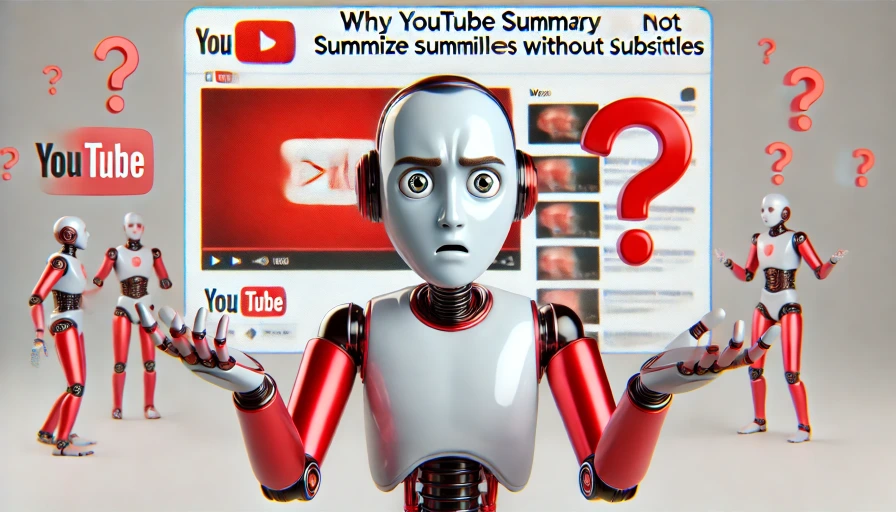
Prompting ChatGPT is Hard: What Actually Works
TL;DR: Most prompt issues come from weak context, fuzzy instructions, and missing validation. We fix this with reliable transcripts, category-specific prompts, and a feedback layer that filters errors.
Artificial intelligence can summarize long videos in seconds, but getting consistent accuracy is another story. If you rely on generic prompts, you’ll get generic mistakes. Below is how we engineer reliable summaries and notable quotes for YouTube videos, and what we learned the hard way.
Why prompting is difficult
Language is ambiguous. Small wording changes shift results. When users say “summarize the key points,” models often infer the wrong audience, level, or scope.
Common failure modes we see:
- Overgeneralization: confident summaries that omit the crux.
- Hallucination: invented facts when the source is thin or noisy.
- Scope creep: the model explains related concepts instead of the actual content.
Verdict: Relying on a single clever prompt is wishful thinking. You need structure, context, and validation.
Context is non‑negotiable
Models optimize for plausibility, not truth. If the input lacks detail, they will fill gaps.
What “good context” looks like:
- Source-grounded text: a transcript or clean notes, not just a video URL.
- Clear task framing: audience, format, and constraints.
- Examples that match the task distribution.
If you skip context, the model guesses. And guessing is where errors start.
How to ask well
You don’t need a magic incantation, but you do need discipline.
Practical tactics that work:
- Provide examples (“few-shot”) that mirror your expected output.
- Specify format and constraints, but avoid contradictory rules.
- Ask the model to plan before answering, especially for multi-step tasks.
See OpenAI’s prompt engineering guidance for examples:
- Few-shot prompting: https://platform.openai.com/docs/guides/prompt-engineering#few-shot-learning
- Encourage reasoning: https://platform.openai.com/docs/guides/prompt-engineering#prompting-reasoning-models
Common issues with ChatGPT prompting
Inaccuracy and fabricated details
Even with the best model, thin inputs produce “likely-sounding” content. This is predictable, not random.
Negation traps
“Do not include X” can backfire. Mentioning X increases its salience. If you must exclude terms, avoid repeating them in the instruction and validate outputs programmatically.
Conflicting instructions
“Be concise but comprehensive” is conflict. Prioritize constraints. Tell the model what to do first, then what to avoid, and keep it consistent.
How we built YouTube Summary to overcome these issues
We engineered the system around three pillars: reliable inputs, category-aware prompts, and strict validation.
1) Reliable transcripts with yt-dlp
We extract transcripts with yt-dlp, then normalize timestamps and segments. Clean source text beats clever prompting every time.
- yt-dlp: https://github.com/yt-dlp/yt-dlp
Why this matters: if the transcript is partial or noisy, the model will speculate. Ground truth reduces hallucinations.
2) Category-specific prompts
We don’t use a one-size prompt. Content is classified into categories like:
- Educational, Technology, Business and Finance, News and Commentary, Science and Nature, Entertainment, Lifestyle, Gaming, Art and Creativity, Wellness and Self-Improvement.
Each category has a tailored prompt template that defines:
- What to extract (claims, steps, arguments, numbers, quotes).
- How to weigh relevance (e.g., for News: sources and dates; for Educational: definitions and steps).
- Output structure (bulleted summary, 1–3 notable quotes with timestamps, optional caveats).
Opinion: category prompts are the fastest path to consistent quality. They serve as policy and reduce prompt drift.
3) Filtering and validation
We treat the model’s output as a draft, not a verdict.
Our checks include:
- Quote validation: each “notable quote” must map to a transcript span with matching wording and timestamp.
- Negation enforcement: a post-processor rejects banned phrases without referencing them in the prompt.
- Consistency scan: we cross-reference names, numbers, and dates against the transcript.
- Retry with constraints: if checks fail, we re-ask with narrowed scope or explicit corrections.
A simple heuristic that works: reject any summary sentence that cannot be supported by at least one transcript snippet within N tokens.
What this looks like in practice
- For a lecture: we extract definitions, theorems, and stepwise proofs. We require at least one exact phrasing from the speaker for quotes.
- For a news segment: we ask for who, what, when, source mentions, and uncertainty. We block absolute claims without attribution.
- For a business interview: we focus on metrics, decisions, and timelines, not generic advice.
This blend of structure and checks reduces hallucinations and keeps the output useful.
Conclusion
Getting accurate results from ChatGPT is less about “the perfect prompt” and more about good inputs, category-aware templates, and verification. That is how we turn long videos into summaries and quotes you can trust.
Author’s note: The biggest gain came when we stopped arguing with the model in the prompt and started validating its outputs like a build pipeline.
FAQ
-
Why does my prompt still include the term I asked to exclude? Negation is unreliable. Use post-processing filters instead of repeating the banned term in the prompt.
-
Can I get accurate summaries without transcripts? Rarely. Provide transcripts or high-quality notes. Otherwise you get guesswork.
-
How many examples should I include? Two to three task-matched examples usually outperform one long generic example.
-
Do category prompts overfit? They specialize. For generality, maintain a base template and layer category rules on top.
References
- OpenAI Prompt Engineering Guide: https://platform.openai.com/docs/guides/prompt-engineering
- yt-dlp documentation: https://github.com/yt-dlp/yt-dlp




